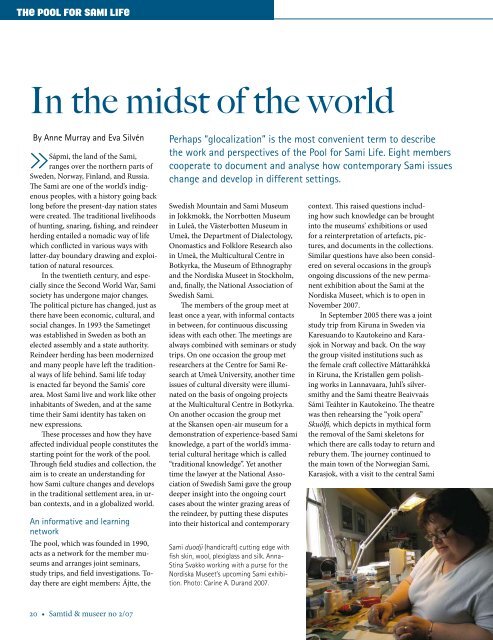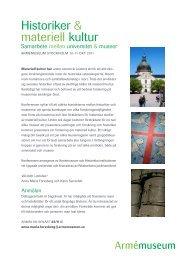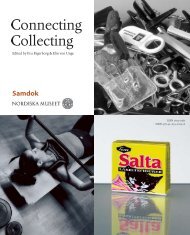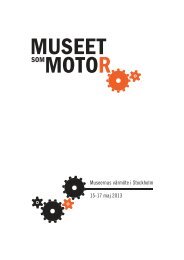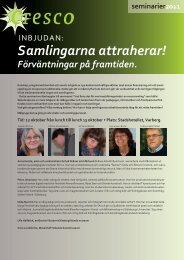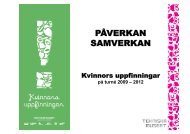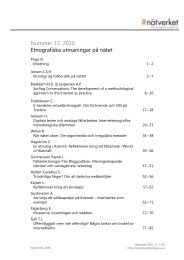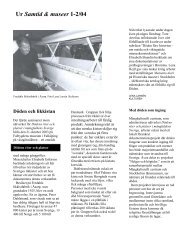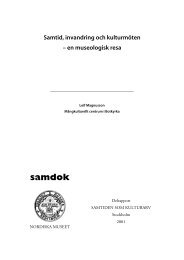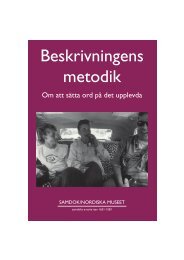Connecting Collecting - Sveriges Museer
Connecting Collecting - Sveriges Museer
Connecting Collecting - Sveriges Museer
You also want an ePaper? Increase the reach of your titles
YUMPU automatically turns print PDFs into web optimized ePapers that Google loves.
The Pool for Sami LifeIn the midst of the worldBy Anne Murray and Eva Silvén»Sápmi, the land of the Sami,ranges over the northern parts ofSweden, Norway, Finland, and Russia.The Sami are one of the world’s indigenouspeoples, with a history going backlong before the present-day nation stateswere created. The traditional livelihoodsof hunting, snaring, fishing, and reindeerherding entailed a nomadic way of lifewhich conflicted in various ways withlatter-day boundary drawing and exploitationof natural resources.In the twentieth century, and especiallysince the Second World War, Samisociety has undergone major changes.The political picture has changed, just asthere have been economic, cultural, andsocial changes. In 1993 the Sametingetwas established in Sweden as both anelected assembly and a state authority.Reindeer herding has been modernizedand many people have left the traditionalways of life behind. Sami life todayis enacted far beyond the Samis’ corearea. Most Sami live and work like otherinhabitants of Sweden, and at the sametime their Sami identity has taken onnew expressions.These processes and how they haveaffected individual people constitutes thestarting point for the work of the pool.Through field studies and collection, theaim is to create an understanding forhow Sami culture changes and developsin the traditional settlement area, in urbancontexts, and in a globalized world.An informative and learningnetworkThe pool, which was founded in 1990,acts as a network for the member museumsand arranges joint seminars,study trips, and field investigations. Todaythere are eight members: Ájtte, thePerhaps “glocalization” is the most convenient term to describethe work and perspectives of the Pool for Sami Life. Eight memberscooperate to document and analyse how contemporary Sami issueschange and develop in different settings.Swedish Mountain and Sami Museumin Jokkmokk, the Norrbotten Museumin Luleå, the Västerbotten Museum inUmeå, the Department of Dialectology,Onomastics and Folklore Research alsoin Umeå, the Multicultural Centre inBotkyrka, the Museum of Ethnographyand the Nordiska Museet in Stockholm,and, finally, the National Association ofSwedish Sami.The members of the group meet atleast once a year, with informal contactsin between, for continuous discussingideas with each other. The meetings arealways combined with seminars or studytrips. On one occasion the group metresearchers at the Centre for Sami Researchat Umeå University, another timeissues of cultural diversity were illuminatedon the basis of ongoing projectsat the Multicultural Centre in Botkyrka.On another occasion the group metat the Skansen open-air museum for ademonstration of experience-based Samiknowledge, a part of the world’s immaterialcultural heritage which is called“traditional knowledge”. Yet anothertime the lawyer at the National Associationof Swedish Sami gave the groupdeeper insight into the ongoing courtcases about the winter grazing areas ofthe reindeer, by putting these disputesinto their historical and contemporarySami duodji (handicraft) cutting edge withfish skin, wool, plexiglass and silk. Anna-Stina Svakko working with a purse for theNordiska Museet’s upcoming Sami exhibition.Photo: Carine A. Durand 2007.context. This raised questions includinghow such knowledge can be broughtinto the museums’ exhibitions or usedfor a reinterpretation of artefacts, pictures,and documents in the collections.Similar questions have also been consideredon several occasions in the group’songoing discussions of the new permanentexhi bition about the Sami at theNordiska Museet, which is to open inNovember 2007.In September 2005 there was a jointstudy trip from Kiruna in Sweden viaKaresuando to Kautokeino and Karasjokin Norway and back. On the waythe group visited institutions such asthe female craft collective Máttaráhkkáin Kiruna, the Kristallen gem polishingworks in Lannavaara, Juhl’s silversmithyand the Sami theatre BeaivvaásSámi Teáhter in Kautokeino. The theatrewas then rehearsing the “yoik opera”Skuólfi, which depicts in mythical formthe removal of the Sami skeletons forwhich there are calls today to return andrebury them. The journey continued tothe main town of the Norwegian Sami,Karasjok, with a visit to the central Sami20 • Samtid & museer no 2/07


